Elsa Cisa, a mother of two young children, lives in Chimborazo. Like mothers the world over, Elsa is constantly concerned with giving the best to her family and keeping them healthy.
In mid-2012, she became a collaborator of the Growing with our Guaguas (Children) Project, which is implemented by the Chimborazo provincial government of Ecuador. Ever since, she has worked as a nutrition technician in Guamote Canton.
Elsita, as her colleagues call her, and nine other technicians have been asked to apply the Informed Decisions Technology (IDT) tool to obtain key information on factors that are influencing the nutrition of boys and girls in Chimborazo.
The IDT was designed in 2007 by the National Feeding and Nutrition Center of Peru as an instrument to manage and monitor nutritional indicators and their determinants. The tool has also been applied in Ecuador and is an example of how south-south cooperation can help countries with similar problems.
“My work is satisfying because the activities I carry out are designed to benefit families in areas such as malnutrition, healthy child checkups, the importance of using the immunization card, food handling, good hygiene and the handwashing initiative, among others,” says Elsita.
“All of this was possible thanks to being able to speak the same language as the people who live in this canton (Kichwa),” she adds, as she interviews a family.
Informed Decisions Technology contains several steps, which include local awareness-raising, preparation and application of the survey, systematization of results –which generate alerts on factors that are influencing nutritional results in the communities where the surveys are conducted– dissemination of results among community leaders and staff of the main institutions present in the community, and finally, the design of action plans.

